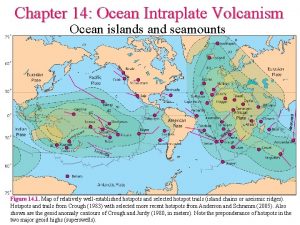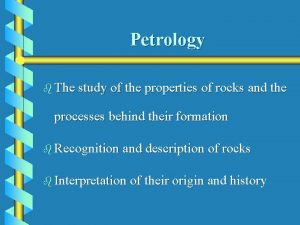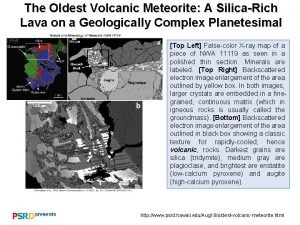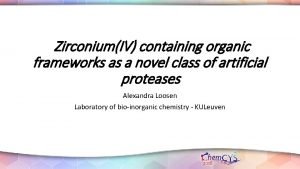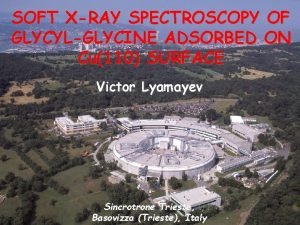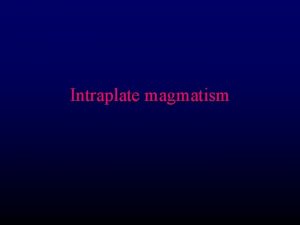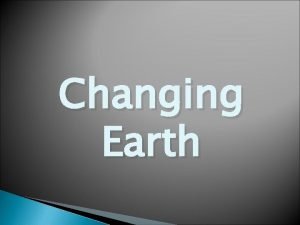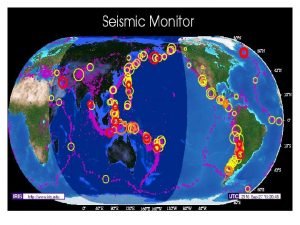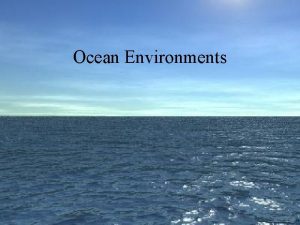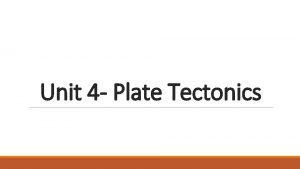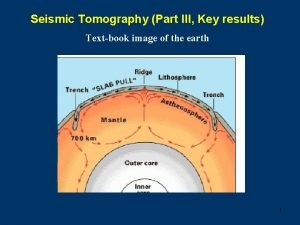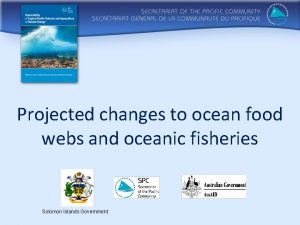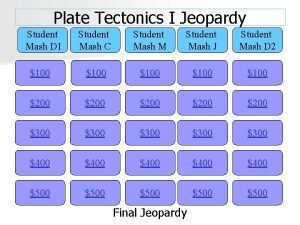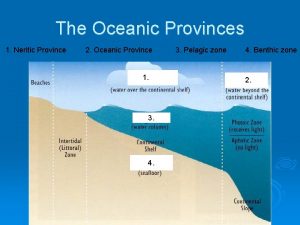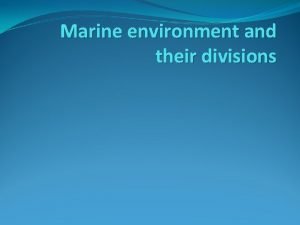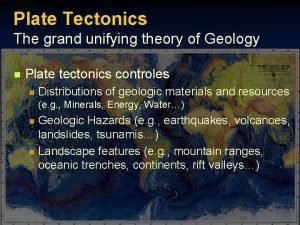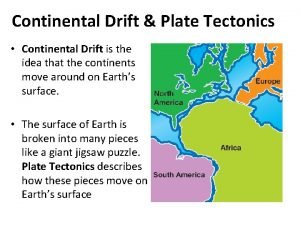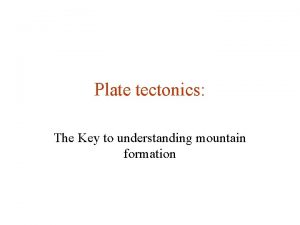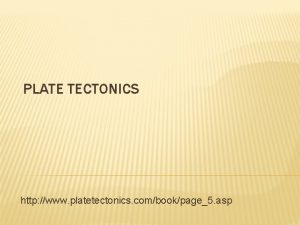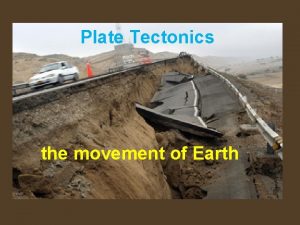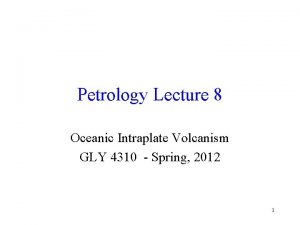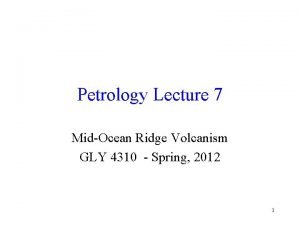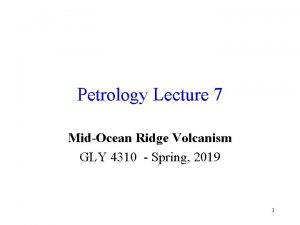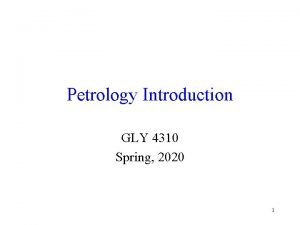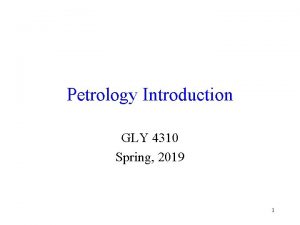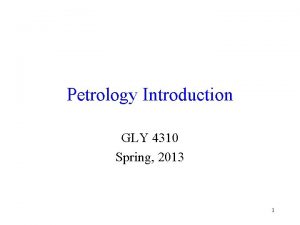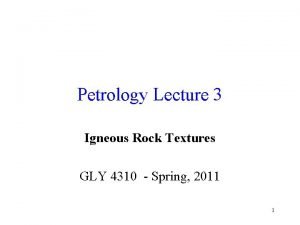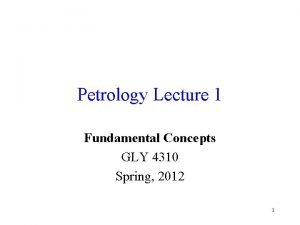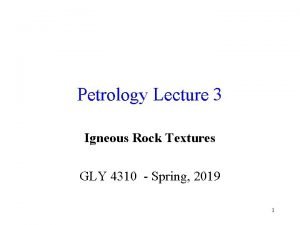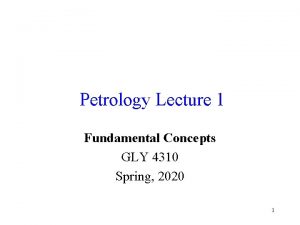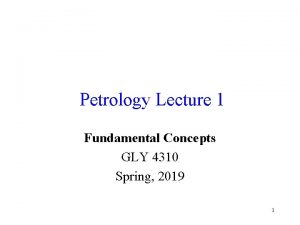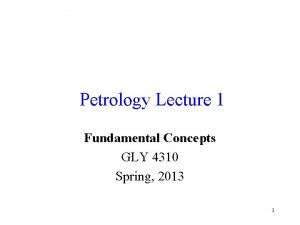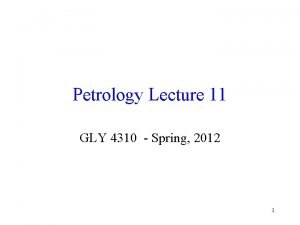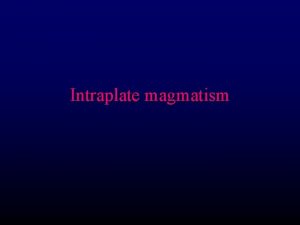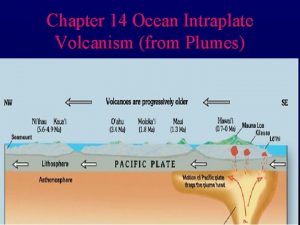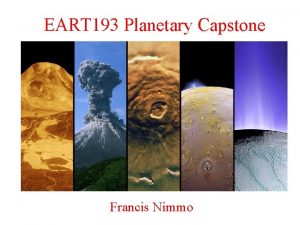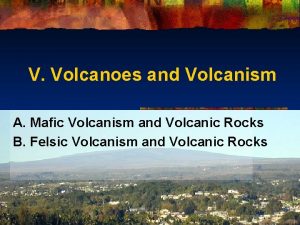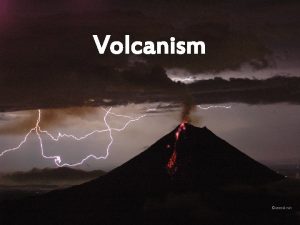Petrology Lecture 8 Oceanic Intraplate Volcanism GLY 4310
































- Slides: 32

Petrology Lecture 8 Oceanic Intraplate Volcanism GLY 4310 - Spring, 2019 1

Hot Spots, Trails, and Aseismic Ridges Figure 14. 1. Map of relatively well-established hotspots and selected hotspot trails (island chains or aseismic ridges). Hotspots and trails from Crough (1983) with selected more recent hotspots from Anderson and Schramm (2005). Also shown are the geoid anomaly contours of Crough and Jurdy (1980, in meters). Note the preponderance of hotspots in the two major geoid highs (superswells). 2

Plume Model • Figure 14. 2 Photograph of a laboratory thermal plume of heated dyed fluid rising buoyantly through a colorless fluid. Note the enlarged plume head, narrow plume tail, and vortex containing entrained colorless fluid of the surroundings. • After Campbell (1998) and Griffiths and Campbell (1990). 3

OIB Magma Types • There are two principal magma series seen in OIB § OIT – stands for Ocean Island Tholeiite • Hawaii is a good example § OIA – Ocean Island Alkaline Basalt • Examples: Canary Islands, the Azores, Ascension, Tristan de Cunha, and Gough Islands in the Atlantic, as well as Tahiti in the Pacific. • Silica undersaturated subseries is the more common type • Slightly silica saturated is less common 4

Hawaii • Best studied of the oceanic islands, by far • Typical eruption sequence § § Pre-sheild Shield-building Post-shield Post-erosional 5

Is Hawaii Typical? • Do the Hawaiian Islands represent a broad trend in the evolution of oceanic intraplate volcanos? § There is a great lack of data for most other islands § Many are small, and most have not been extensively studied § If the Hawaiian processes are general, than alkaline islands should be tholeiitic underwater § This has not been tested because of cost constraints, and the very real difficulties of drilling in the turbulent waters near an island 6

OIT vs. MORB Chemistry 7

Chemistry of Silica Undersaturated Alkaline Series 8

Chemistry of Silica Oversaturated Alkaline Series 9

Alkali vs. Silica 10

Si. O 2 - Na. Al. Si. O 4 - KAl. Si. O 4 - H 2 O 11

Alkali/ Silica Ratios, Ocean Islands 12

OIB Trace Element Chemistry • LIL – Large-Ion Lithophile ions § K, Rb, Cs, Ba, Pb 2+, and Sr § Incompatible with silicate minerals, except for Ba and Sr in plagioclase • HFS – High-Field Strength Ions § Th, U, Ce, Zr, Hf, Nb, Ta, and Ti 13

K/Ba Ratio 14

REE for OIB, N-MORB, and E-MORB Figure 14. 4. After Wilson (1989) Igneous Petrogenesis. Kluwer 15

Spider Diagram for OIB Figure 14 -5. Winter (2010) An Introduction to Igneous and Metamorphic Petrology. Prentice Hall. Data from Sun and Mc. Donough (1989). 16

Nb/U ratio • Figure 14. 6. Nb/U ratios vs. Nb concentration in fresh glasses of both MORBs and OIBs. The Nb/U ratio is impressively constant over a range of Nb concentrations spanning over three orders of magnitude (increasing enrichment should correlate with higher Nb). From Hofmann (2003). Chondrite and continental crust values from Hofmann et al. (1986). 17

Binary All analyses fall between two reservoirs as magmas mix Mixing of Reservoirs Ternary All analyses fall within triangle determined by three reservoirs Figure 14. 7. Winter (2001) An Introduction to Igneous and Metamorphic Petrology. Prentice Hall. 18

Isotope Ratios for OIB and MORB Figure 14 -8. After Zindler and Hart (1986), Staudigel et al. (1984), Hamelin et al. (1986) and Wilson (1989). 19

Mantle Reservoirs 1. DM (Depleted Mantle) = N-MORB source Figure 14. 8. After Zindler and Hart (1986), Staudigel et al. (1984), Hamelin et al. (1986) and Wilson (1989).

2. BSE (Bulk Silicate Earth) or the Primary Uniform Reservoir Figure 14. 8. After Zindler and Hart (1986), Staudigel et al. (1984), Hamelin et al. (1986) and Wilson (1989).

5. PREMA (PREvalent MAntle) Figure 14. 8. After Zindler and Hart (1986), Staudigel et al. (1984), Hamelin et al. (1986) and Wilson (1989).

3. EMI = enriched mantle type I has lower 87 Sr/86 Sr (near primordial) 4. EMII = enriched mantle type II has higher 87 Sr/86 Sr (> 0. 720), well above any reasonable mantle sources Figure 14. 8. After Zindler and Hart (1986), Staudigel et al. (1984), Hamelin et al. (1986) and Wilson (1989).

Pb Isotopes Pb produced by radioactive decay of U & Th 234 U 206 Pb 235 U 207 Pb 232 Th 208 Pb • 238 U • • 24

Pb Is Quite Scarce in the Mantle • Mantle-derived melts are susceptible to contamination from UTh-Pb-rich reservoirs which can add a significant proportion to the total Pb • U, Pb, and Th are concentrated in sialic reservoirs, such as the continental crust, which develop high concentrations of the radiogenic daughter Pb isotopes • 204 Pb is non-radiogenic, so 208 Pb/204 Pb, 207 Pb/204 Pb, and 206 Pb/204 Pb increase as U and Th decay • Oceanic crust has elevated U and Th content (compared to the mantle) as will sediments derived from oceanic and continental crust • Pb is perhaps the most sensitive measure of crustal (including sediment) components in mantle isotopic systems • Since 99. 3% of natural U is 238 U, the 206 Pb/204 Pb will be most sensitive to a crustal-enriched component 25

Pb Isotope Ratios for MORB’s and OIB’s, Atlantic and Pacific Figure 14 -9. After Wilson (1989) Igneous Petrogenesis. Kluwer. 26

Origin of HIMU • μ = 238 U/204 Pb, and is used to evaluate uranium enrichment • The HIMU reservoir is quite distinctive in the Pb system, having a very high 206 Pb/204 Pb ratio, suggestive of a source with high U, yet not enriched in Rb, and old enough (> 1 Ga) to develop the observed isotopic ratios by radioactive decay over time • Several models have been proposed for this reservoir, including subducted and recycled oceanic crust (possibly contaminated by seawater), localized mantle lead loss to the core, and Pb-Rb removal by those dependable (but difficult to document) metasomatic fluids • The similarity of the rocks from St. Helena Island to the HIMU reservoir has led some workers to call this reservoir the “St. Helena component” 27

Pb Isotope Ratios for MORB’s and OIB’s, Atlantic, Pacific & Indian Oceans Figure 14. 10 After Wilson (1989) Igneous Petrogenesis. Kluwer. Data from Hamelin and Allègre (1985), Hart (1984), Vidal et al. (1984). 28

Isotopic Ratios of Various Reservoirs 29

Pb Isotope Anomaly Contours Figure 14. 11. From Hart (1984) Nature, 309, 753 -756. 30

Oceanic Volcanism Model Figure 14. 19. Schematic model for oceanic volcanism. Nomenclature from Zindler and Hart (1986) and Hart and Zindler (1989). 31

143 Nd/ 144 Nd vs. 87 Sr/ 86 Sr, Hawaii Odd: Tholeiites exhibit enriched isotopic characteristics and alkalic is more depleted (opposite to usual mantle trends for OIA-OIT). Probably due to more extensive partial melting in the plume axial area (→ tholeiites) where the deep enriched plume source is concentrated Less extensive partial melting (→ OIA) in the margins where more depleted upper mantle is entrained Figure 14. 21. 143 Nd/144 Nd vs. 87 Sr/86 Sr for Maui and Oahu Hawaiian early tholeiitic shield-building, and later alkaline lavas. From Wilson (1989). Copyright © by permission Kluwer Academic Publishers. 32
 Intraplate volcanism
Intraplate volcanism Ocean to ocean convergent boundary
Ocean to ocean convergent boundary Continent continent convergent
Continent continent convergent Rg 4310/2018
Rg 4310/2018 Petrology is the study of
Petrology is the study of Volcanism
Volcanism Gly
Gly Gly
Gly Optical isomerism in octahedral complexes
Optical isomerism in octahedral complexes Intraplate magmatism
Intraplate magmatism Plumes schematic
Plumes schematic 01:640:244 lecture notes - lecture 15: plat, idah, farad
01:640:244 lecture notes - lecture 15: plat, idah, farad Oceanic or continental
Oceanic or continental Oceanic plate
Oceanic plate Happens when two oceanic plates collide
Happens when two oceanic plates collide Oceanic zones
Oceanic zones Which part of the earth is the hottest?
Which part of the earth is the hottest? Oceanic crust age
Oceanic crust age Oceanic airlines 747
Oceanic airlines 747 Neritic zone climate
Neritic zone climate Tuna food web
Tuna food web The cross section below depicts magnetized oceanic crust
The cross section below depicts magnetized oceanic crust Pelagic province
Pelagic province Oceanic divisions
Oceanic divisions Bluefin tuna food web
Bluefin tuna food web Harry hess and seafloor spreading
Harry hess and seafloor spreading Oceanic crust age
Oceanic crust age A denser oceanic plate collides with a continental plate
A denser oceanic plate collides with a continental plate Boundary
Boundary San andreas fault plate boundary
San andreas fault plate boundary Convergence of two oceanic plates oreo
Convergence of two oceanic plates oreo Mountain plates
Mountain plates New york oceanic
New york oceanic
